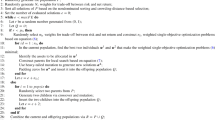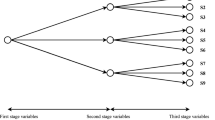Abstract
Financial market has systemic complexity and uncertainty. For investors, return and risk often coexist. How to rationally allocate funds into different assets and achieve excess returns with effectively controlling risk are main problems to be solved in the field of portfolio optimization (PO). At present, due to the influence of modeling and algorithm solving, the PO models established by many researchers are still mainly focused on single-stage single-objective models or single-stage multi-objective models. PO is actually considered as a multi-stage multi-objective optimization problem in real investment scenarios. It is more difficult than the previous single-stage PO model for meeting the realistic requirements. In this paper, the authors proposed a mean-improved stable tail adjusted return ratio-maximum drawdown rate (M-ISTARR-MD) PO model which effectively characterizes the real investment scenario. In order to solve the multi-stage multi-objective PO model with complex multi-constraints, the authors designed a multi-stage constrained multi-objective evolutionary algorithm with orthogonal learning (MSCMOEA-OL). Comparing with four well-known intelligence algorithms, the MSCMOEA-OL algorithm has competitive advantages in solving the M-ISTARR-MD model on the proposed constructed carbon neutral stock dataset. This paper provides a new way to construct and solve the complex PO model.
Similar content being viewed by others
References
Markowitz H M, Portfolio selection, Journal of Finance, 1952, 7(1): 77–91.
Mao J C T, Models of capital budgeting, EV vs ES, Journal of Financial and Quantitative Analysis, 1970, 4(5): 657–675.
Konno H and Yamazaki H, Mean-absolute deviation portfolio optimization model and its applications to Tokyo stock market, Management Science, 1991, 37(5): 519–531.
Jorion P, Value at Risk: The New Benchmark for Controlling Market Risk, McGraw-Hill, Chicago, 1997.
Tsao C Y, Portfolio selection based on the Mean-VaR efficient frontier, Quantitative Finance, 2010, 10(8): 931–945.
Baixauli-Soler J S, Alfaro-Cid E, and Fernandez-Blanco M O, Mean-VaR portfolio selection under real constraints, Computational Economics, 2011, 37(2): 113–131.
Zhou K, Gao J, Li D, et al., Dynamic Mean-VaR portfolio selection in continuous time, Quantitative Finance, 2017, 17(10): 1631–1643.
Rockafellar R T and Uryasev S, Optimization of conditional value-at-risk, Journal of Risk, 2000, 2: 21–42.
Yao H, Li Z, and Lai Y, Mean-CVaR portfolio selection: A nonparametric estimation framework, Computers & Operations Research, 2013, 40(4): 1014–1022.
Iyengar G and Ma A K C, Fast gradient descent method for Mean-CVaR optimization, Annals of Operations Research, 2013, 205(1): 203–212.
Guo X, Chan R H, Wong W K, et al., Mean-variance, Mean-VaR, and Mean-CVaR models for portfolio selection with background risk, Risk Management, 2019, 21(2): 73–98.
Bera A K and Park S Y, Optimal portfolio diversification using the maximum entropy principle, Econometric Reviews, 2008, 27(4–6): 484–512.
Usta I and Kantar Y M, Mean-variance-skewness-entropy measures: A multi-objective approach for portfolio selection, Entropy, 2011, 13(1): 117–133.
Zhou R, Zhan Y, Cai R, et al., A mean-variance hybrid-entropy model for portfolio selection with fuzzy returns, Entropy, 2015, 17(5): 3319–3331.
Deng X, Zhao J, and Li Z, Sensitivity analysis of the fuzzy mean-entropy portfolio model with transaction costs based on credibility theory, International Journal of Fuzzy Systems, 2018, 20(1): 209–218.
Bhattacharyya R, Chatterjee A, and Kar S, Uncertainty theory based multiple objective mean-entropy-skewness stock portfolio selection model with transaction costs, Journal of Uncertainty Analysis and Applications, 2013, 1(1): 1–17.
Wu H and Li Z, Multi-period mean-variance portfolio selection with Markov regime switching and uncertain time-horizon, Journal of Systems Science and Complexity, 2011, 24(1): 140–155.
Chen Y, Zhao X, and Yuan J, Swarm intelligence algorithms for portfolio optimization problems: Overview and recent advances, Mobile Information Systems, 2022, 2022: 1–15.
Rasmussen K M and Clausen J, Mortgage loan portfolio optimization using multi-stage stochastic programming, Journal of Economic Dynamics and Control, 2007, 31(3): 742–766.
Glpinar N and Rustem B, Worst-case robust decisions for multi-period mean-variance portfolio optimization, European Journal of Operational Research, 2007, 183(3): 981–1000.
Huang X and Qiao L, A risk index model for multi-period uncertain portfolio selection, Information Sciences, 2012, 217: 108–116.
Zhang W G, Liu Y J, and Xu W J, A possibilistic mean-semivariance-entropy model for multi-period portfolio selection with transaction costs, European Journal of Operational Research, 2012, 222(2): 341–349.
Liu Y J, Zhang W G, and Xu W J, Fuzzy multi-period portfolio selection optimization models using multiple criteria, Automatica, 2012, 48(12): 3042–3053.
He J, Wang Q G, Cheng P, et al., Multi-period mean-variance portfolio optimization with high-order coupled asset dynamics, IEEE Transactions on Automatic Control, 2014, 60(5): 1320–1335.
Li B, Zhu Y, Sun Y, et al., Multi-period portfolio selection problem under uncertain environment with bankruptcy constraint, Applied Mathematical Modelling, 2018, 56: 539–550.
Jin X, Chen N, and Yuan Y, Multi-period and tri-objective uncertain portfolio selection model: A behavioral approach, The North American Journal of Economics and Finance, 2019, 47: 492–504.
Dai Y and Qin Z, Multi-period uncertain portfolio optimization model with minimum transaction lots and dynamic risk preference, Applied Soft Computing, 2021, 109: 107519.
Gupta P, Mehlawat M K, and Khan A Z, Multi-period portfolio optimization using coherent fuzzy numbers in a credibilistic environment, Expert Systems with Applications, 2021, 167: 114135.
Kim J H, Lee Y, Kim W C, et al, Goal-based investing based on multi-stage robust portfolio optimization, Annals of Operations Research, 2022, 313(2): 1141–1158.
Mei Y, Chen Z, Liu J, et al, Multi-stage portfolio selection problem with dynamic stochastic dominance constraints, Journal of Global Optimization, 2022, 83(3): 585–613.
Asgari H and Behnamian J, Multi-objective stock market portfolio selection using multi-stage stochastic programming with a harmony search algorithm, Neural Computing and Applications, 2022, 1–18.
Golubin A Y, Optimal investment policy in a multi-stage problem with bankruptcy and stage-by-stage probability constraints, Optimization, 2022, 71(10): 2963–2977.
Li R, Zhao X, Zuo X, et al., Memetic algorithm with non-smooth penalty for capacitated arc routing problem, Knowledge-Based Systems, 2021, 220: 106957.
Zhao X, Feng S, Hao J, et al., Neighborhood opposition-based differential evolution with Gaussian perturbation, Soft Computing, 2021, 25(1): 27–46.
Li K, Chen R, Fu G, et al., Two-archive evolutionary algorithm for constrained multiobjective optimization, IEEE Transactions on Evolutionary Computation, 2018, 23(2): 303–315.
Liu Z Z and Wang Y, Handling constrained multiobjective optimization problems with constraints in both the decision and objective spaces, IEEE Transactions on Evolutionary Computation, 2019, 23(5): 870–884.
Chen Y and Zhou A, MOEA/D with an improved multi-dimensional mapping coding scheme for constrained multi-objective portfolio optimization, 2019 IEEE Congress on Evolutionary Computation (CEC), IEEE, 2019, 1742–1749.
Woldesenbet Y G, Yen G G, and Tessema B G, Constraint handling in multiobjective evolutionary optimization, IEEE Transactions on Evolutionary Computation, 2009, 13(3): 514–525.
Jan M A and Zhang Q, MOEA/D for constrained multiobjective optimization: Some preliminary experimental results, 2010 UK Workshop on Computational Intelligence (UKCI), IEEE, 2010, 1–6.
Deb K and Jain H, An evolutionary many-objective optimization algorithm using reference-point based non-dominated sorting approach, Part I: Solving problems with box constraints, IEEE Transactions on Evolutionary Computation, 2014, 18(4): 577–601.
Li K, Deb K, Zhang Q, et al., An evolutionary many-objective optimization algorithm based on dominance and decomposition, IEEE Transactions on Evolutionary Computation, 2014, 19(5): 694–716.
Tian Y, Zhang T, Xiao J, et al., A coevolutionary framework for constrained multiobjective optimization problems, IEEE Transactions on Evolutionary Computation, 2020, 25(1): 102–116.
Ming M, Wang R, Ishibuchi H, et al, A novel dual-stage dual-population evolutionary algorithm for constrained multi-objective optimization, IEEE Transactions on Evolutionary Computation, 2021, 26(5): 1129–1143.
Ding Z, Chen L, Sun D, et al., A multi-stage knowledge-guided evolutionary algorithm for large-scale sparse multi-objective optimization problems, Swarm and Evolutionary Computation, 2022, 73: 101119.
Cui Y, Meng X, and Qiao J, A multi-objective particle swarm optimization algorithm based on two-archive mechanism, Applied Soft Computing, 2022, 119: 108532.
Martin R D, Rachev S Z, and Siboulet F, Phi-alpha optimal portfolios and extreme risk management, The Best of Wilmott 1: Incorporating the Quantitative Finance Review, 2003, 1: 223.
Garca Garca F, Gonzlez-Bueno J, Guijarro F, et al., Multiobjective approach to portfolio optimization in the light of the credibility theory, Technological and Economic Development of Economy, 2020, 26(6): 1165–1186.
Rao M, Chen Y, Vemuri B C, et al., Cumulative residual entropy: A new measure of information, IEEE Transactions on Information Theory, 2004, 50(6): 1220–1228.
Zhou J, Li X, and Pedrycz W, Mean-semi-entropy models of fuzzy portfolio selection, IEEE Transactions on Fuzzy Systems, 2016, 24(6): 1627–1636.
Zhou J and Li X, Mean-semi-entropy portfolio adjusting model with transaction costs, Journal of Data, Information and Management, 2020, 2(3): 121–130.
Wang C F, Yang J L, and Zhao X, The Portfolio management model with typical transaction cost and its solution, Systems Engineering — Theory & Practice, 2004, 19(2): 193–197 (in Chinese).
Fang C D, Wei Z X, and Zhang M Y, The portfolio model with typical transaction cost based on CVaR, Journal of Guangxi University (Natural Science Edition), 2015, 40(6): 1611–1616.
Zhan Z H, Zhang J, Li Y, et al., Orthogonal learning particle swarm optimization, IEEE Transactions on Evolutionary Computation, 2010, 15(6): 832–847.
Ho S Y, Lin H S, Liauh W H, et al., OPSO: Orthogonal particle swarm optimization and its application to task assignment problems, IEEE Transactions on Systems, Man, and Cybernetics-Part A: Systems and Humans, 2008, 38(2): 288–298.
Jain H and Deb K, An evolutionary many-objective optimization algorithm using reference-point based non-dominated sorting approach, part II: Handling constraints and extending to an adaptive approach, IEEE Transactions on Evolutionary Computation, 2014, 18(4): 602–622.
Jiao R, Zeng S, Li C, et al., Handling constrained many-objective optimization problems via problem transformation, IEEE Transactions on Cybernetics, 2020, 51(10): 4834–4847.
Tian Y, Cheng R, Zhang X, et al., An indicator-based multiobjective evolutionary algorithm with reference point adaptation for better versatility, IEEE Transactions on Evolutionary Computation, 2017, 22(4): 609–622.
Author information
Authors and Affiliations
Corresponding author
Additional information
This research was supported by the National Natural Science Foundation of China under Grant No. 61973042 and Beijing Natural Science Foundation under Grant No. 1202020.
Rights and permissions
About this article
Cite this article
Chen, Y., Ye, L., Li, R. et al. A Multi-Period Constrained Multi-Objective Evolutionary Algorithm with Orthogonal Learning for Solving the Complex Carbon Neutral Stock Portfolio Optimization Model. J Syst Sci Complex 36, 686–715 (2023). https://doi.org/10.1007/s11424-023-2406-3
Received:
Revised:
Published:
Issue Date:
DOI: https://doi.org/10.1007/s11424-023-2406-3




